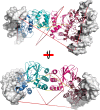Structural Analysis of the Regulatory Domain of ExsA, a Key Transcriptional Regulator of the Type Three Secretion System in Pseudomonas aeruginosa
- PMID: 26317977
- PMCID: PMC4552939
- DOI: 10.1371/journal.pone.0136533
Structural Analysis of the Regulatory Domain of ExsA, a Key Transcriptional Regulator of the Type Three Secretion System in Pseudomonas aeruginosa
Abstract
Pseudomonas aeruginosa employs a type three secretion system to facilitate infections in mammalian hosts. The operons encoding genes of structural components of the secretion machinery and associated virulence factors are all under the control of the AraC-type transcriptional activator protein, ExsA. ExsA belongs to a unique subfamily of AraC-proteins that is regulated through protein-protein contacts rather than small molecule ligands. Prior to infection, ExsA is inhibited through a direct interaction with the anti-activator ExsD. To activate ExsA upon host cell contact this interaction is disrupted by the anti-antiactivator protein ExsC. Here we report the crystal structure of the regulatory domain of ExsA, which is known to mediate ExsA dimerization as well as ExsD binding. The crystal structure suggests two models for the ExsA dimer. Both models confirmed the previously shown involvement of helix α-3 in ExsA dimerization but one also suggest a role for helix α-2. These structural data are supported by the observation that a mutation in α-2 greatly diminished the ability of ExsA to activate transcription in vitro. Additional in vitro transcription studies revealed that a conserved pocket, used by AraC and the related ToxT protein for the binding of small molecule regulators, although present in ExsA is not involved in binding of ExsD.
Conflict of interest statement
Figures




Similar articles
-
Backbone Interactions Between Transcriptional Activator ExsA and Anti-Activator ExsD Facilitate Regulation of the Type III Secretion System in Pseudomonas aeruginosa.Sci Rep. 2020 Jun 18;10(1):9881. doi: 10.1038/s41598-020-66555-z. Sci Rep. 2020. PMID: 32555263 Free PMC article.
-
Self-trimerization of ExsD limits inhibition of the Pseudomonas aeruginosa transcriptional activator ExsA in vitro.FEBS J. 2013 Feb;280(4):1084-94. doi: 10.1111/febs.12103. Epub 2013 Jan 24. FEBS J. 2013. PMID: 23279839 Free PMC article.
-
ExsD inhibits expression of the Pseudomonas aeruginosa type III secretion system by disrupting ExsA self-association and DNA binding activity.J Bacteriol. 2010 Mar;192(6):1479-86. doi: 10.1128/JB.01457-09. Epub 2009 Dec 11. J Bacteriol. 2010. PMID: 20008065 Free PMC article.
-
Fitting Pieces into the Puzzle of Pseudomonas aeruginosa Type III Secretion System Gene Expression.J Bacteriol. 2019 Jun 10;201(13):e00209-19. doi: 10.1128/JB.00209-19. Print 2019 Jul 1. J Bacteriol. 2019. PMID: 31010903 Free PMC article. Review.
-
Yersinia Type III Secretion System Master Regulator LcrF.J Bacteriol. 2015 Dec 7;198(4):604-14. doi: 10.1128/JB.00686-15. J Bacteriol. 2015. PMID: 26644429 Free PMC article. Review.
Cited by
-
1.65 Å resolution structure of the AraC-family transcriptional activator ToxT from Vibrio cholerae.Acta Crystallogr F Struct Biol Commun. 2016 Sep;72(Pt 9):726-31. doi: 10.1107/S2053230X1601298X. Epub 2016 Aug 26. Acta Crystallogr F Struct Biol Commun. 2016. PMID: 27599865 Free PMC article.
-
ExoS effector in Pseudomonas aeruginosa Hyperactive Type III secretion system mutant promotes enhanced Plasma Membrane Rupture in Neutrophils.PLoS Pathog. 2025 Apr 2;21(4):e1013021. doi: 10.1371/journal.ppat.1013021. eCollection 2025 Apr. PLoS Pathog. 2025. PMID: 40173191 Free PMC article.
-
HilD, HilC, and RtsA Form Homodimers and Heterodimers To Regulate Expression of the Salmonella Pathogenicity Island I Type III Secretion System.J Bacteriol. 2020 Apr 9;202(9):e00012-20. doi: 10.1128/JB.00012-20. Print 2020 Apr 9. J Bacteriol. 2020. PMID: 32041797 Free PMC article.
-
Backbone Interactions Between Transcriptional Activator ExsA and Anti-Activator ExsD Facilitate Regulation of the Type III Secretion System in Pseudomonas aeruginosa.Sci Rep. 2020 Jun 18;10(1):9881. doi: 10.1038/s41598-020-66555-z. Sci Rep. 2020. PMID: 32555263 Free PMC article.
-
Structure of the master regulator Rns reveals an inhibitor of enterotoxigenic Escherichia coli virulence regulons.Sci Rep. 2021 Aug 2;11(1):15663. doi: 10.1038/s41598-021-95123-2. Sci Rep. 2021. PMID: 34341412 Free PMC article.
References
Publication types
MeSH terms
Substances
Grants and funding
LinkOut - more resources
Full Text Sources
Other Literature Sources

